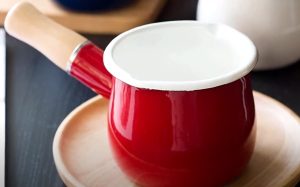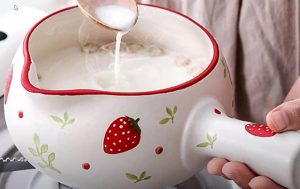So you’ve got your eyes on a ceramic milk pan. Smart move. This kitchen staple does more than just warm up your milk for that creamy latte. With its top-notch thermal efficiency, it’s perfect for those delicate sauces and even baby food—without scorching.
You’ll get the scoop on design perks like comfy maple wood handles and why enameled steel might be your new best friend in durability. And if online shopping is your jam, we’re breaking down shipping fees so there are no surprises at checkout.
By the end of this read, you’ll know how to pick one that fits right into your cooking groove—and use it like a pro to boot.
Table Of Contents:
- Understanding Ceramic Milk Pans and Their Unique Qualities
- Design Features of Top Ceramic Milk Pans
- Selecting Your Ideal Ceramic Milk Pan
- How to Use Your Ceramic Milk Pan Effectively
- FAQs in Relation to Ceramic Milk Pan
Understanding Ceramic Milk Pans and Their Unique Qualities
 Ceramic milk pans are the unsung heroes of the kitchen, boasting a design that’s both practical and chic. If you’re someone who appreciates a tool that can do more than just warm up your morning cup of tea coffee or handle baby food with care, then ceramic is calling your name.
Ceramic milk pans are the unsung heroes of the kitchen, boasting a design that’s both practical and chic. If you’re someone who appreciates a tool that can do more than just warm up your morning cup of tea coffee or handle baby food with care, then ceramic is calling your name.
The Appeal of Ceramic Material in Cookware
When it comes to cookware, ceramic material isn’t just another pretty face. It’s got thermal efficiency down pat, thanks to its natural insulation properties. This means when you’re gently simmering milk for a velvety sauce or coaxing chocolate into silky submission for dessert, there’s no fear of scorching—just smooth sailing all the way.
Surely we’ve all felt the pang of dissatisfaction when cleaning burnt remnants from pots—but hand wash woes become less daunting with ceramic milk pans. The surface resists sticking like an old friend refusing to leave after dinner; cleanup is often as simple as wiping away any messes before they set up camp on your pan’s enameled interior.
Why Milk Pots Are Essential in Modern Kitchens
Gone are the days where ‘milk pot’ was code for ‘single-use gadget’. These versatile vessels take on everything from steamy soups to rich gravies without batting an eyelid—or losing their cool (quite literally). So whether you need something small enough not to drown oatmeal yet capacious enough at 49 fluid oz (1.45 liters) like the Kaico Milk Pan, rest assured these modern marvels have got your back—and burner covered.
If variety is indeed the spice life demands within our culinary exploits then having one compatible across induction, gas and electric stovetops only spices things further. Now if only finding matching table linens were this easy…
Enameled Steel Versus Pure Ceramic Construction
Talk about standing out in a crowd—enameled steel designs such as those by Koizumi Studio marry durability with impeccable heat retention abilities found in pieces like the Kaico Milk Pan, whose dimensions boast 6 1/4″ x 12 1/2″ x 3 3/4″. On one hand pure ceramics promise similar endurance but differ slightly on heating dynamics—a subtle nuance discernible perhaps only by connoisseurs but worthy note nonetheless.
Maple Wood Handles for Comfort and Style
Lest we forget aesthetics amidst this symphony function brings us maple wood handles—not merely comfortable grips providing safe passage from stove top tableau sans singed fingertips but also crowning our culinary instruments with a touch of elegance. These wooden features are not just practical; they’re a nod to classic design, marrying form and function seamlessly in the kitchen dance.
Design Features of Top Ceramic Milk Pans
When you’re on the hunt for a ceramic milk pan, it’s like searching for that perfect pair of jeans. You want something that looks great but also holds up to everyday use. Let me walk you through some features that make these pans stand out in your kitchen lineup.
Enameled Steel Versus Pure Ceramic Construction
Ceramic milk pans come in two main styles: enameled steel and pure ceramic. The Kaico Milk Pan by Koizumi Studio is a prime example of elegance meeting function with its enameled steel body and porcelain enamel finish, boasting dimensions fit for any stove at 6 1/4″ x 12 1/2″ x 3 3/4″. Now, don’t let the term ‘steel’ throw you off—this isn’t your average metal pot.
The beauty here lies in heat retention. Enameled steel heats up quickly and distributes warmth evenly; imagine every drop of milk warming at the same cozy rate without hotspots scorching your precious sauce or baby food—a true testament to thermal efficiency. But let’s not forget about our pure ceramic contenders—they bring their A-game when it comes to slow-cooking soups or simmering tea coffee blends as they hold onto heat longer than most guests stick around after dinner.
Maple Wood Handles for Comfort and Style
A handle can make or break a pan—literally. So why settle for less? Maple wood handles are more than just pretty face-lifts; they offer an oasis from the sizzling dance floor that is stovetop cooking.
Koizumi Studio didn’t just choose maple wood handles because they complemented their model number perfectly (although we admit it does look smashing). They chose them because nobody likes doing an impromptu firewalk test while straining pasta. Wooden handles keep things cool so you can shake, rattle, and roll all over those burners without losing grip—or style points.
If this piqued your interest, take a moment to check out other kitchen essentials. Whether selecting cookware or sprucing up with some garden decor or table linens—the right tools matter as much as good ingredients do.
Picking out new gear should be fun—not fretful over shipping fees. While we won’t get into exact numbers here (since they change faster than fashion trends), remember quality pieces like these often come with perks such as rewards points or satisfaction guarantees—which means peace of mind along with no surprise charges waiting on your bill).
Selecting Your Ideal Ceramic Milk Pan
Shopping for the right ceramic milk pan is like finding a new best friend for your kitchen – one that’s reliable, versatile, and brings out the best in everything you cook. But let’s face it; with so many options on the market, pinpointing that perfect match can be as tricky as deciding between tea or coffee.
Understanding Shipping Charges When Purchasing Online
Say goodbye to buyer’s remorse by getting savvy about shipping surcharges before hitting ‘checkout.’ While we all love a good deal, don’t let an attractive sale price blindside you to extra costs. Consider this: A shipping rate isn’t just a number—it represents handling care and ensures your precious cargo arrives intact from our warehouse to your doorstep. And if you’re keeping tabs on expenses, here are finds under $50, but remember to check if there’s an additional packing list charge because those little fees add up.
We’ve all been there—anticipation turns into frustration when a high shipping fee pops up at checkout. So always peek at what’s included in the regular price and weigh it against any potential surprise gift of added charges.
The Appeal of Ceramic Material in Cookware
Ceramic milk pans aren’t just another pretty piece among your kitchen accessories—they’re champs at locking heat thanks to their thermal efficiency. This means whether you’re simmering baby food or whipping up soup pot magic, these pans do more than warm milk; they maintain consistent temperatures without making your energy bills sweat.
If durability gives you peace of mind, then rest easy knowing that ceramic material won’t flinch at daily use. From its resistance against scratches while hand washing to standing firm against carbon steel competitors—a ceramic milk pan holds its own.
Why Milk Pots Are Essential in Modern Kitchens
Milk pots have come a long way since grandma used them solely for her famed hot cocoa recipe; now they play multiple roles flawlessly within modern culinary realms—think casserole ceramic hero by night and enameled steel companion during daybreak brunches. Check out various styles suitable for every cooking need, because versatility should never compromise style—or breakfast time satisfaction guarantee promises.
Remember folks – picking out that ideal buddy (ahem… I mean ‘ceramic milk pan’) shouldn’t feel like decoding hieroglyphs. Stick with me through thick soups and thin sauces—we’ll navigate together through each detail ensuring no stone (or rather lid) is left unturned.
How to Use Your Ceramic Milk Pan Effectively
 A ceramic milk pan isn’t just for your grandma’s hot cocoa recipe. This kitchen hero is versatile, perfect for your morning tea or coffee, and a whiz at baby food prep. But let’s not stop there. The right technique can turn this humble pot into the MVP of your cooking routine.
A ceramic milk pan isn’t just for your grandma’s hot cocoa recipe. This kitchen hero is versatile, perfect for your morning tea or coffee, and a whiz at baby food prep. But let’s not stop there. The right technique can turn this humble pot into the MVP of your cooking routine.
The Right Heat Makes All the Difference
Whether you’re working with an electric stovetop or gas cooker, keep that flame gentle. Your ceramic milk pan is like that chill best friend who thrives on low-key vibes; it distributes heat evenly but doesn’t rush things. So go ahead and melt chocolate without fear of scorching or warm up soup knowing every spoonful will be as cozy as the last.
But remember—patience pays off here. High heat might tempt you when in a hurry, but it’s no pal to ceramics. Keep it mellow and watch how everything from sauces to oatmeal comes out just right.
Savvy Stirring Strategies
No one likes cleaning burnt milk from their favorite pot, so give those wrists a workout and stir regularly while heating liquids like tea coffee concoctions or cream-based soups. By stirring often with a wooden spoon (metal ones could scratch), you’re giving love back to that pan ceramic heartthrob by preventing sticking and burning.
If whispers around the cooktop are true—and they usually are—a maple wood handle keeps hands cool while offering up some extra classiness too.
Cleaning: A Gentle Touch Goes Far
We’ve all been there—soaking pans overnight because we dreaded scrubbing them clean after dinner mayhem ensued on our countertops—but listen closely: hand wash this beauty gently with soap and water instead of tossing it in the dishwasher’s wild ride through Splatville (also known as aggressive washing cycles).
Kitchen accessories, such as soft sponges or brushes designed specifically for non-stick surfaces, work wonders here.
Remember these tips next time you reach for that under $50 gem or consider splurging on something northward of $100. With care like this, satisfaction guarantee should feel more than just words—it becomes reality etched onto every delicious memory created using your trusty ceramic companion.
FAQs in Relation to Ceramic Milk Pan
Which is the best milk pan?
The Kaico Milk Pan nails it with top-notch thermal efficiency and a stylish maple wood handle.
What is the purpose of a milk pan?
Milk pans are clutch for heating liquids gently, but they’re also ace for sauces and melting chocolate.
What is the difference between a saucepan and a milk pan?
Saucepans are larger multitaskers; milk pans specialize in small-scale, delicate cooking tasks. Think precision versus versatility.
Can you cook anything in a milk pan?
You bet. A ceramic milk pan can handle oats to custards – just keep portions on the smaller side.
